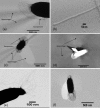Physical characteristics of spores of food-associated isolates of the Bacillus cereus group
- PMID: 20023097
- PMCID: PMC2812992
- DOI: 10.1128/AEM.02116-09
Physical characteristics of spores of food-associated isolates of the Bacillus cereus group
Abstract
All 47 food-borne isolates of Bacillus cereus sensu stricto, as well as 10 of 12 food-borne, enterotoxigenic isolates of Bacillus thuringiensis, possessed appendages. Spores were moderately to highly hydrophobic, and each had a net negative charge. These characteristics indicate that spores of food-associated B. thuringiensis and not only B. cereus sensu stricto have high potential to adhere to inert surfaces.
Figures

References
-
- Abram, D. 1966. Differentiation in cells of Bacillus circulans Q19 during spore formation, p. 261-262. In R. Uyeda (ed.), Electron microscopy, vol. II. Maruzen Co., Ltd., Tokyo, Japan.
-
- Agata, N., M. Ohta, M. Mori, and M. Isobe. 1995. A novel dodecadepsipeptide, cereulide, is an emetic toxin of Bacillus cereus. FEMS Microbiol. Lett. 129:17-20. - PubMed
-
- Andersson, A., U. Rönner, and P. E. Granum. 1995. What problems does the food industry have with the spore-forming pathogens Bacillus cereus and Clostridium perfringens? Int. J. Food Microbiol. 28:145-155. - PubMed
-
- Ankolekar, C., and R. Labbe. 2009. Survival during cooking and growth from spores of diarrheal and emetic types of Bacillus cereus in rice. J. Food Protect. 72:2386-2389. - PubMed
-
- Ankolekar, C., T. Rahmati, and R. Labbé. Prevalence of toxigenic Bacillus cereus and Bacillus thuringiensis spores in U.S. retail rice. Int. J. Food Microbiol. 128:460-466. - PubMed
MeSH terms
LinkOut - more resources
Full Text Sources
Other Literature Sources

